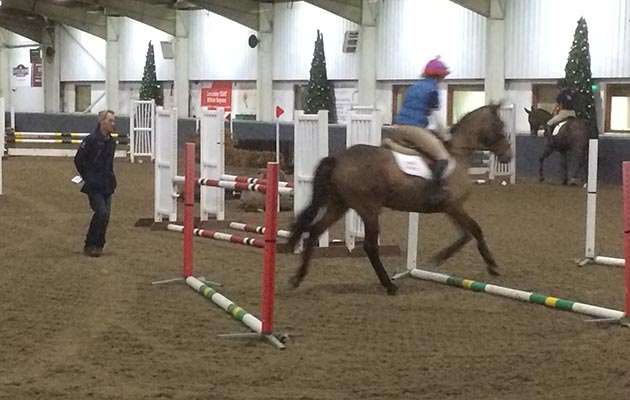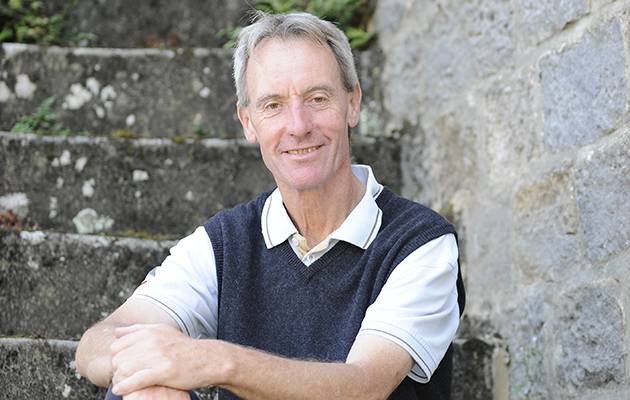If you’re going eventing next season, then who could possibly be better to learn from than the current British eventing team performance coach, Chris Bartle?
He has helped transform top riders to become competitive at the very highest echelons of the sport, but his key training ideas are relevant to horses and riders at all levels, as he demonstrated during a recent masterclass at Keysoe with horses and riders competing from BE100 to advanced level.
“Cross-country in the modern sport of eventing is about turning lines, jumping fences on extreme angles, and the lines you have to hold between the fences,” explains Chris. “In this way you have to bring your dressage training into the cross-country phase.
“Of course you still need a horse that’s bold enough to take on the ditches and water, but it must have a partnership with the rider and both must be disciplined to be successful. How we communicate the question to the horse and how the rider guides the horse is key.”

Chris’ top tips: warming-up
A rider cannot force a horse to relax and if the horse is tense it cannot perform to its best. Quietly work the horse as you would at home and give it as much time as it needs to settle before asking it to perform. This will take as long as it takes.
Taking young horses out and about to experience ‘life’ without competing so they learn to relax in the competition environment is an important part of their education.
Chris prefers all training to be done without a martingale. “In cross-country at the highest level the martingale is more of a hindrance than a help,” he says. “Also horses that come behind the vertical can be made worse by a martingale.”
If a horse feels tight and tense, lengthen the rein and allow the neck out. Let the horse stick its head in the air if it want to. It’s only important that the horse goes in the direction asked – not that it’s in an outline.
If the horse is tense, hold and support with the inside leg and control the line with the outside rein. Allow the horse to look to the outside. The inside rein should be the horse’s friend, the outside rein is the discipline rein and brings the shoulder into line. Avoid pressure on both sides of the horse’s mouth at the same time. The horse must accept and respond to the rider’s inside leg.
Encourage the horse to take the nose forward and stretch the neck. Once he is relaxed, let him stretch and then he’s ready to start work.
A useful training exercise for all levels
A training exercise that Chris uses frequently is a ground pole to an oxer to a ground pole, with three and bit human strides between each element. The pole on the landing side encourages the horse to look down on landing. The oxer should be square. All the groups worked through this exercise at an appropriate level.

Once the horse is jumping the exercise confidently, pull both sides of the oxer out to make it wider but don’t move the ground poles. This encourages the horse to jump higher and make a better bascule with a sharper take off and steeper landing, which helps to develop the horse’s scope without making the fence any higher.
It is key that the rider gives the horse freedom to use its neck to the maximum to achieve the more extravagant bascule, while not getting in front of the movement on take off, staying in balance through the air and not tipping forward on landing.
Chris Bartle’s top takeways
- Balance and impulsion give you options in front of a fence
- The rider’s position is key to successful cross-country
- Always aim for the slight inside line (inside the midline) in a turning combination – it saves time and distance
- Use slight outside flexion to control the horse’s outside shoulder on the approach
- Find the fence, find the line, be aware of the distance, but don’t focus your eyes on the jump, look beyond it
- Allow the horse to work/jump underneath you while you stay balanced and look ahead.
- “Land in your feet” from every jump to avoid tipping forward
- If your horse is keen to a fence, keep the outside flexion slightly longer on the approach
- Use your seat, core and body position to encourage a horse to steady if they are onward bound
- If your horse is tense or buzzy, continue with the exercise until the horse relaxes, only then move on
- The length and freedom of the horse’s neck is core to all of Chris’s training
Christopher shared these and more helpful tips during a masterclass organised by the British Eventing Charitable Foundation at Keysoe in Bedfordshire (21 November). Chris will be hosting another masterclass at Kingston Maurward College in Dorset during the evening of Monday 4 December.




